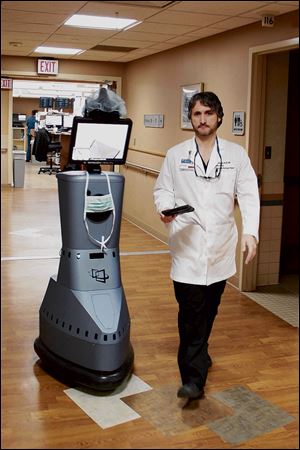
Many tools available to combat stroke
Time of essence to patients in need of care
5/19/2014
Dr, John Whapham is Director of the Mercy Neurointerventional and Stroke Program. Telemedicine is the use of an autonomous, drivable robot that allows a decrease in response time to assessment and thereby acute treatment.
This is one of a series of columns about health issues written by staff members of ProMedica, Mercy, Toledo Clinic, and the University of Toledo Medical Center, the former Medical College of Ohio.
Every second counts for a patient experiencing a stroke or sustaining a traumatic injury.
More than 750,000 strokes occur each year in the United States with only 5 percent to 6 percent currently getting intervention and treatment. Early diagnosis and the start of treatment is essential.
Telemedicine is the use of real-time medical information exchanged from one site to another via electronic video communications and “tele-presence” to improve a patient’s clinical health status (americantelemed.org). It is the future of global health care and is a critical tool for stroke and other traumatic time-sensitive illnesses.
Time is everything when a patient is having a stroke or has been seriously injured in an accident. The telemedical robot enables specialists at a medical center to have a live presence — in a completely different location — allowing specialists to assess the patient, view films and talk with care givers to determine the best course of treatment in concert with physicians present remotely. Instead of relying just on phone contact, physicians can see and hear and examine firsthand what is happening with a patient and determine the best course of treatment.
Various medical devices can be transmitted via the robot, including stethoscope, EKG and ultrasound. The autonomous, drivable robot allows a decrease in response time to assessment and thereby acute treatment.
In addition a hospital’s ground and air ambulance can also be equipped with telemedicine units, allowing patients to be assessed at the scene of an accident or in flight while keeping in contact with the physicians on the ground. The portable equipment can also project in-field ultrasound to check for traumatic internal injuries. This helps the receiving hospital be prepared for emergent surgery or other treatments.
Other benefits of Telemedicine include:
● Allowing for connected care services so specialist can gather and examine the patients via one robot or look at test results as a group regardless of the physicians location.
● Providing access to the right provider in the right setting at the right time.
● Improving health via a better continuity across the continuum of care.
● Allowing specialists time to begin treatment and preparation for hospitals to receive extremely ill patients. In some cases the patient can skip the ER and go straight to the cath lab or the surgery suite upon arrival.
● Ability to help outlying hospitals decide to keep the patient in their community rather than making that decision without specialist evaluation.
As health care finds its place in the evolving world of technology patients are learning to accept these new care scenarios in the interest of time and urgent care. According to a 2013 Cisco study, 70 percent of patients are comfortable communicating with physicians via texting, email, or video instead of in person.
John Whapham, MD, MS, FSNIS, FAAN is Director of the Mercy Neurointerventional and Stroke Program.